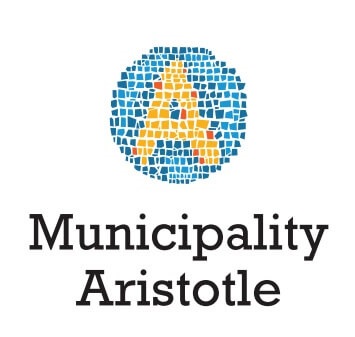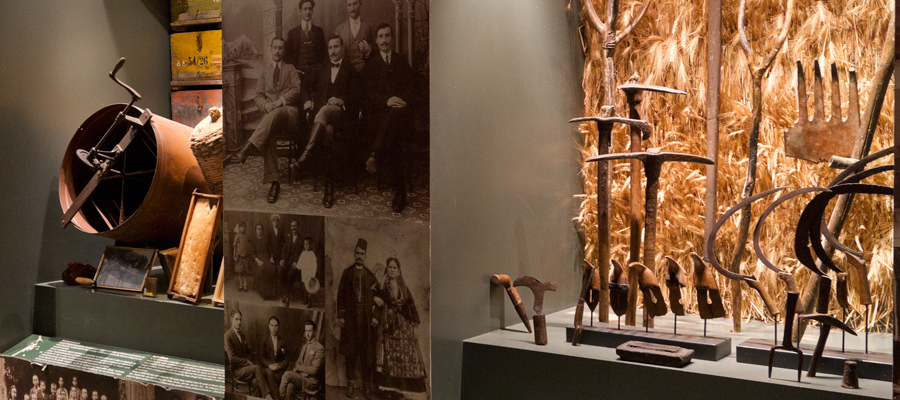The customs and traditions of a people are the characteristics that shape the identity of their place. They are the elements that constitute their roots and the unbreakable bonds with their homeland and ancestors. Arnaia is characterized by the richness of its folkloric tradition, a large part of which is occupied by its customs and traditions.
Particular customs that are not found in other regions, such as the Swallowing Song, Kotsmanous, Kourbania, the Christ’s Melomati, Sussaritsa, the traditional village wedding, the weighing of St. George, etc.
- The very old custom of the “Christ’s Melomati” took place on the evening of Christmas Eve. All the families of Arnaia gathered around the Christmas table to cut the Christ bread. For several years now, the Cultural and Educational Society of Arnaia has moved this custom to the central square of the village, in order to strengthen the bonds among the residents. On the morning of Christmas Eve, the Christ bread is prepared in the workshop, and late in the afternoon, along with walnuts and honey, it is carried to the central square. The mixed choir of the Municipality of Arnaia and the municipal band sing carols and other Christmas songs. All attendees hold lit lanterns. Then, the Christ bread, walnuts, and honey are distributed to the people.
- On Cheese Sunday, during Carnival, a parade of disguised people takes place in the town square.
- On Easter Sunday morning, the custom of the “Easter Kiosk” is revived in the town. The residents gather in the central square and distribute red eggs, tsourekia, and pies to passersby, wishing “Christ is Risen” and “Many Years.” The children’s section of the Aristotelian Cultural Center’s dance group also participates in the process.
- On Easter Monday morning, a very old custom called “Kantari” is revived in Arnaia. It involves a large scale, the kantari, which is hung by the residents on the centuries-old plane tree in the central square of the village. On this scale, people, mainly those who have increased weight, are weighed.
- Particular mention should be made of the significant custom of “Koutsmanous“, which first appeared during the period of Ottoman rule, and this name is likely derived from a corruption of the name of the Turkish Aga (Kotsm-anlis – Koutsmanous). On the 3rd day of Easter, horsemen from the central square of Arnaia, dressed in traditional Arnaian attire and armed, head to the hill of Prophet Elias. There, a Divine Liturgy is held, and then the procession of the holy icons takes place with the riders. Immediately after, the traditional dance “koutsmanous” begins. Horse races and a shooting contest follow, where the participants aim at red eggs hanging from a rope. It should be noted that during the period of Ottoman rule, this custom had great significance as, through the shooting, the residents practiced the use of weapons for a potential future uprising, unbeknownst to the Turkish conquerors. Today, the winners are given praise. The horsemen then return from the chapel and gather in the central square of Arnaia, where a large collective celebration and dance take place.
- The custom of “Soussaritsa” is a competition for children and adults. It is organized on this day in the grove of Agia Paraskevi Arnaia. The participants, after being divided into opposing teams, throw red eggs on the grass. The winner is the one who throws the egg as far as possible without it breaking.
- Noteworthy is the custom of the “Swallowing Song“, which takes place on the 1st of March each year. March 1st is considered the celebration of spring, and it is believed that on this day the swallows arrive as harbingers of spring. The “Swallowing Song” is, therefore, the welcoming of spring. In this event, the village children, school students dressed in local traditional costumes, go out into the streets of the village and sing the traditional swallow song. They hold a wooden box, open at the front, through which a wooden stick with the figure of a swallow attached is passed. The stick is wrapped with a rope, which they pull, causing the swallow figure to move up and down. The children also carry two piggy banks and 2-3 baskets, in which they collect money and treats given by the people of Arnaia. The Swallowing Song goes as follows:
- Swallow comes from Arabia,
brings – brings Spring, brings Summer too,
and we came here to ask you,
to give us 5 eggs, 5 eggs, 5 cock eggs
and another 5 on Easter
so the hen can lay eggs
and bring the birds
as the mother does with her children.
March has come to us
welcome it with joy,
the trees are blossoming,
the meadows are greening,
and the animals are happy.
Outside fleas, mice,
inside health and peace
and may our Easter be joyful.
Live long to hear
Swallow Amen. - Saint Modestos, the protector of animals, is honored on December 18th at his chapel by the herders of Arnaia. Equally important is the feast of Saint Modestos, held on the first Saturday of June with Kourbani (a meat stew with bulgur added). When the Kourbani is ready, the bells ring and call the people to the churchyard for its distribution. Then, all attendees dance and celebrate in the square with the accompaniment of musical instruments (zournas and daoulia).
- Significant in Arnaia’s folkloric tradition is also the liargovino song. Most of the local songs of Arnaia are based on stories and are preserved through traditions. These songs refer to legends, traditions, and religious festivals, some are frontier and historical, and all fall within the spectrum of Greek folk melodies and poetry.
* Text by the archaeologist Athena Marathianou.



